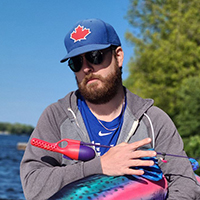On this lifelong angling adventure, the pursuit of steelhead has been consistent. I first fished for steelhead in the mid-1970s with fly gear. In those days, the typical set-up for fishing steelhead on the north shore of Lake Superior was a fiberglass fly rod with snake eyes and a Martin 72 reel. In place of fly line, most local anglers ran 12-pound test Maxima line. The fly was a simple tie using multi-coloured yarn, often bought from the lady’s section in Eaton’s. This was before specialized steelhead gear. Then, centre-pin reels and floats came along, and that soon became the primary way anglers caught steelhead right across the province. I‘d wager that is still the case today. In recent years, however, I’ve returned to fly fishing for steelhead most of the time. What I’ve been doing is a basic technique, but so satisfying to use and catch fish with. Fly fishing can also catch steelhead in places where a float angler will struggle. The basics The fly fishing set-up I like to use for steelhead is simple and versatile. The fly rod is an eight-weight, 10-footer. This rod is able to handle big fish in heavy water but works well in low-flow conditions. On smaller streams or creeks, a nine-foot rod may be a better choice. For a reel, I use a tough, Canadian-made Islander fly reel. The Islander is compact and has a consistent drag. Many other fly reels can be used, just make sure they have a consistent, dependable drag. The fly line is an eight-weight, weight-forward floating line. I like to use a brightly coloured fly line as it’s more visible in low light and often doubles as a strike indicator. I’ll run a nine-foot leader of eight-to-12-pound monofilament or fluorocarbon leader, depending on the situation. I rarely run a light leader as I hate breaking off both fish and flies. Steelhead flies A world of flies is available to the angler, and many can catch steelhead in the right situation. My approach to steelhead angling flies is basic: A mix of egg patterns, nymphs, attractor flies, streamers, and beads covers almost all the situations for most steelhead fishing. Egg patterns like the Glo Bug, Cactus Fly, Bead Head Crystal Sucker, and Sucker Spawn fit the bill for much steelhead fishing. Steelhead will pick off an egg that drifts by out of instinct. It is a small
Please log into your OFAH Community account to access this content. Not an OFAH member or Ontario OUT of DOORS Subscriber? Follow the links below to join or subscribe and gain access to exclusive online content.




Contact Information
PO Box 2800 / 4601 Guthrie Dr.
Peterborough, Ontario Canada K9J 8L5
Phone: 705-748-OFAH (6324)
Fax: 705-748-9577
Join Our Newsletter
Watch
Shop
Follow